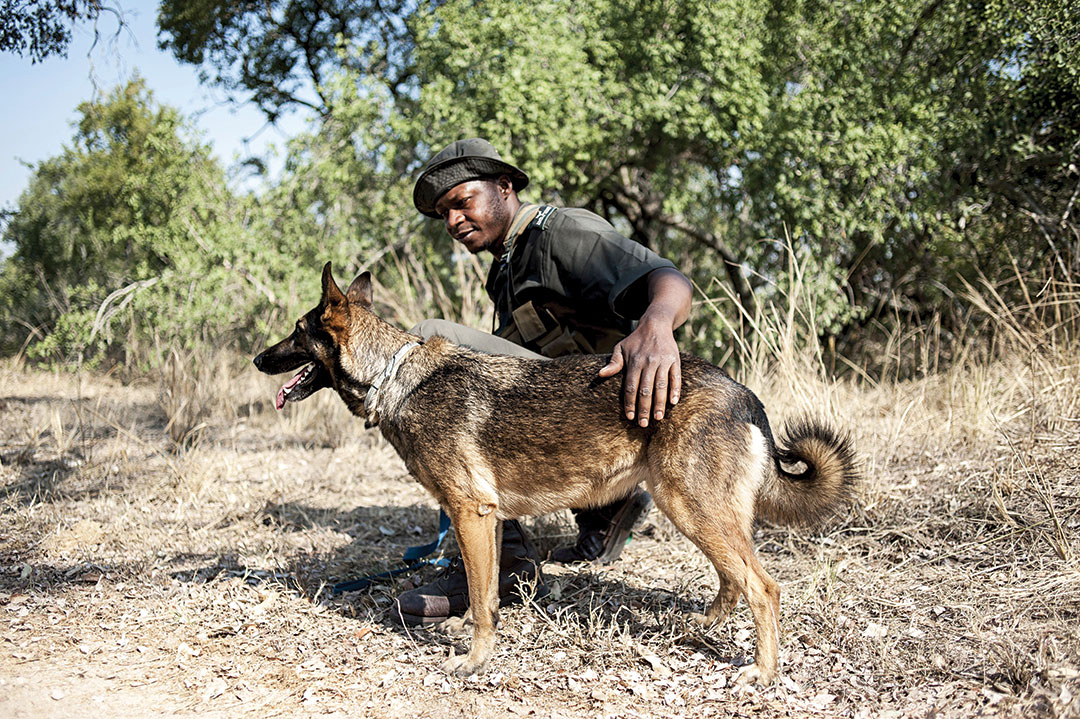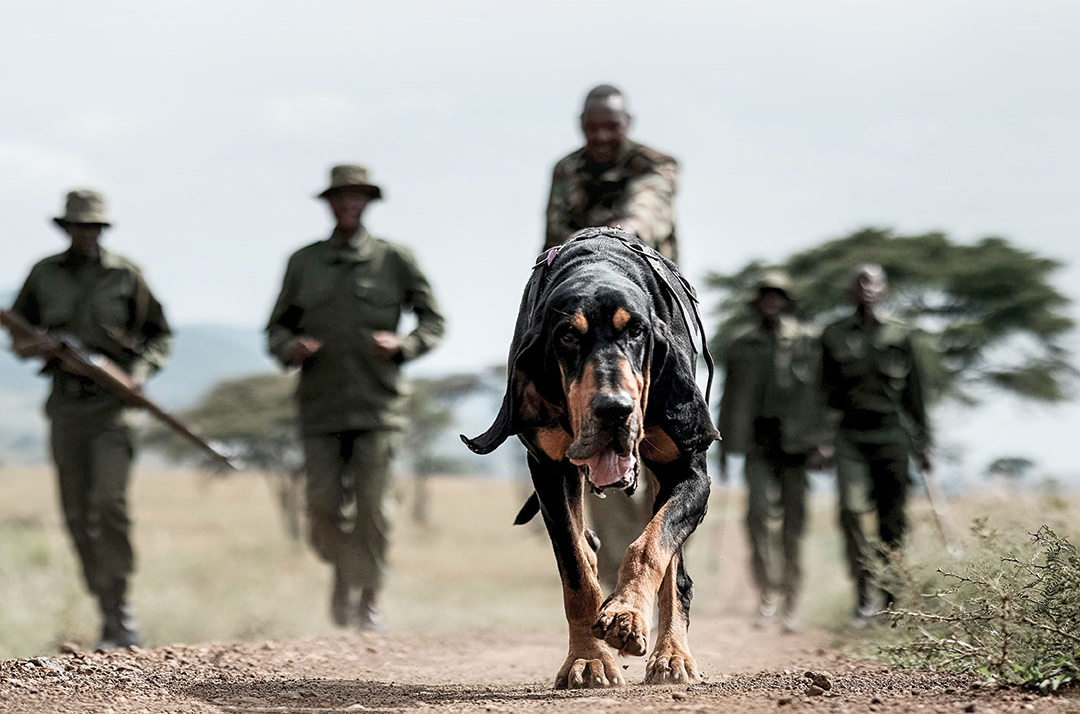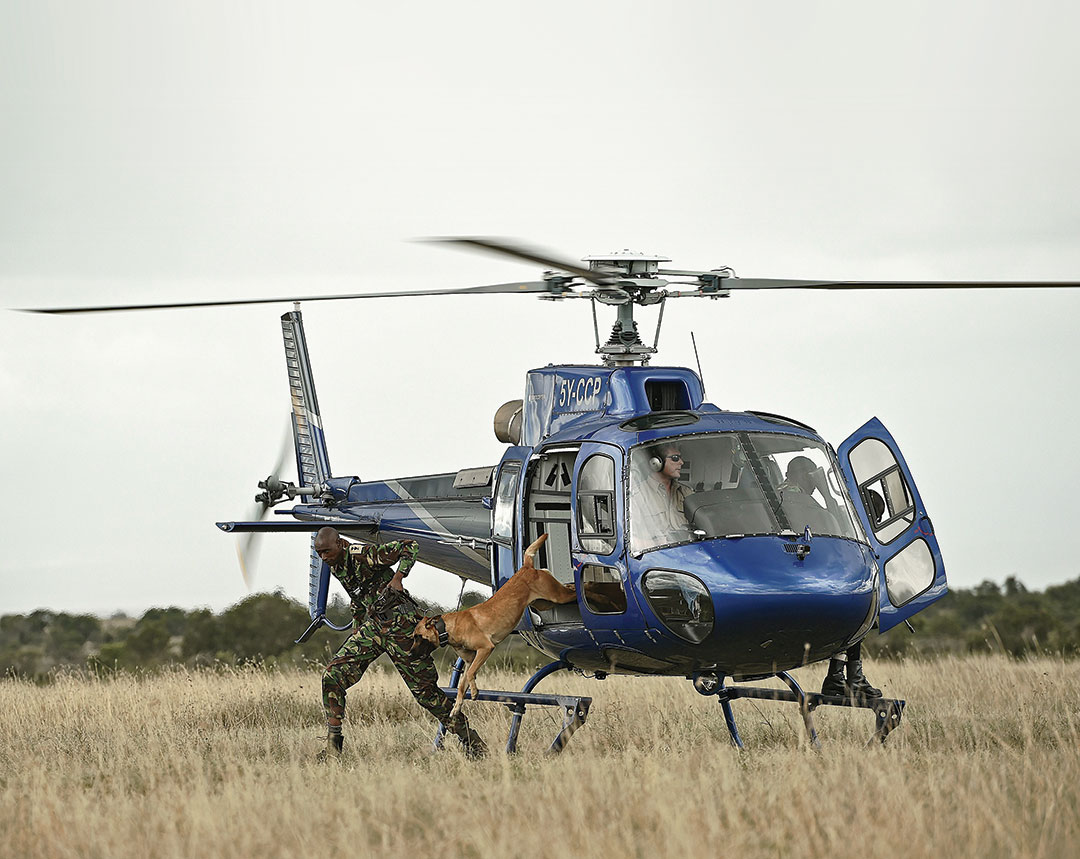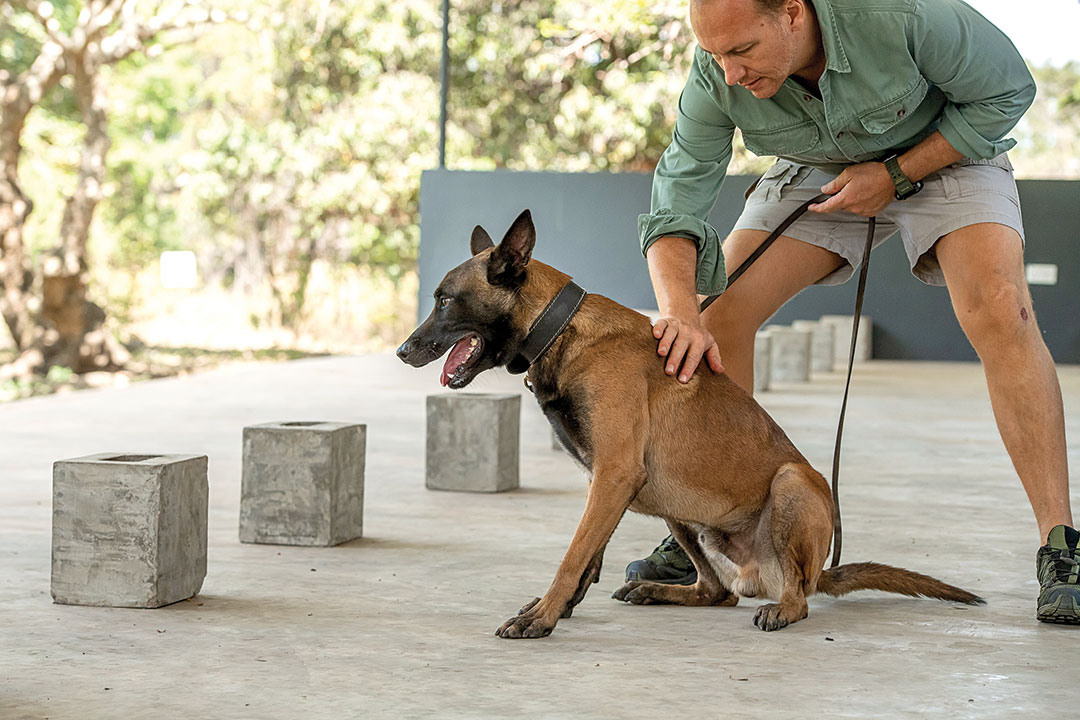ADF STAFF
As poachers go high-tech with helicopters, animal sedatives and high-powered rifles, the men and women protecting endangered wildlife are going old school — with dogs.
Conservation authorities in Zimbabwe and South Africa say that poachers now fly in helicopters over game parks to identify rhinos and, while airborne, shoot drugs at the animals to sedate them.
Once targeted animals become weakened, the rustlers land and brutally cut off their horns with chainsaws. There are no mercy killings here; the animals are left to bleed to death. To put them out of their misery would be to attract vultures, which would, in turn, alert authorities.
The scope of the problem is devastating. For instance, Kruger National Park in South Africa spends $13.5 million annually on anti-poaching efforts. It has the most highly trained and dedicated anti-poaching force in Africa. The conservation news service MongaBay reports that the park has been divided into 22 sections, each with its own section ranger and a team of field rangers. The rangers have helicopter support and the South African National Defence Force to help. Yet with all this money spent and all the effort, hundreds of rhinos are still poached each year in Kruger. Although the number has decreased in recent years, it is partly because there are fewer and fewer rhinos left to poach, with their numbers having declined in Kruger since 2011.

As wildlife officials look for new ways to protect rhinos, elephants and other animals from poachers, they are increasingly relying on highly trained dogs — “dogs with master’s degrees,” as some have called them.
The dogs come from other parts of the world to join the mission. Ireland dispatched a 14-month-old Dutch shepherd named Scout to a South African reserve. The Independent of the United Kingdom reported that such dogs, properly trained, are valued at more than $30,000 and can be used to “help protect the rhinos, park rangers and even reserve personnel.” Although the dog from Ireland was already highly trained, he began a new intensive training course in South Africa to prepare him for his new environment.
Then there’s Drum, who was 10 months old in 2019 when he arrived at the Ol Pejeta Conservancy in Kenya. The charity Animals Saving Animals trained the spaniel from the United Kingdom. The dog, said the conservancy, has proven to have an “exceptional ability” to detect ammunition and weapons. His job mainly involves vehicle searches.
“I hand-picked him from a litter when he was 8 weeks old,” dog trainer Daryll Pleasants told the conservancy. “As a puppy, he was always bouncing around, and that’s perfect for the job; it’s a very active role.”
Animals Saving Animals was founded in 2016 and now trains dogs for use all over the world. Pleasants said he believes his dogs have helped reduce poaching in some areas by up to 72%.
DOGS FROM AROUND THE WORLD
Dogs of varying breeds, including Belgian Malinois, Weimaraners, English springer spaniels, German shepherds and German shorthaired pointers, have been dispatched to Africa to stalk poachers, sniff out contraband at airports and assist in vehicle stops.
Under good conditions, a dog can detect the presence of a poacher up to a kilometer away. This makes anti-poaching officers much better equipped to track at night and cover more ground.
The African Wildlife Foundation established its dog program, Canines for Conservation, in 2014. The dogs have taken part in 400 seizures of illegal wildlife material such as elephant tusks, rhino horns and pangolin scales since then. Most of the products were headed for China and other parts of Southeast Asia to be used in bogus traditional Chinese medicine products.
Wildlife workers who have never worked with dogs, except perhaps guard dogs, have come to respect the animals.
“Dog handling has become a sought-after job among employees of wildlife authorities in Tanzania, Kenya, Uganda, Mozambique, Botswana and most recently Cameroon,” tweeted Albert Schenk of the Wildlife Conservation Society. The handlers typically learn to work with the dogs over the course of eight to 10 weeks.
Canines for Conservation Director Will Powell told the BBC that the program is a public-private partnership with governments that helps them develop dog units within their wildlife organizations.
“That includes strategy, standard operating procedures and veterinary protocol,” he said. “With their help, we select rangers and train them as detection dog handlers.”
Powell chooses his dogs in Europe, in countries that already have a culture of working dogs. His career as a dog trainer began with teaching them to detect land mines.
The first class of Canines for Conservation graduated in July 2015, along with handlers from the Kenya Wildlife Service and the Tanzania Wildlife Division. The dogs were deployed to the primary airports and seaports of the two countries. From January through August 2016, the dog teams based at Kenya’s Jomo Kenyatta International Airport discovered more than 26 caches of ivory, rhino horn and pangolin scales.

AGGRESSIVE PURSUIT DOGS
Powell’s dogs are trackers, not attackers. But trainers in other organizations sometimes take a different approach. In Zimbabwe, dogs trained by Pleasants are equipped with armor for self-defense.
In 2018, two armored dogs, Polaris and Rogue, tracked poachers and covered enough ground in an hour in low light to find the men.
“The poachers panic, drop their equipment, including heavy-caliber ammunition, and surrender,” The Independent of the U.K. reported. “Before night falls, the poaching team has intercepted and arrested a gang and recovered dangerous arms.”
“At night when our eyes become useless, that’s when the dog nose really helps us,” one dog trainer told the news website Insider. “The idea is to get the team close enough to the poacher that the team will then be able to make an arrest.”

VERSATILE MALINOIS
The Belgian Malinois breed, which is similar to German shepherds, has proven useful in tracking poachers because of its intelligence, power, agility and, in some cases, bite strength. The breed has been used in military operations around the world and as guard dogs. Some trainers say that one dog and its handler can cover an area 60 times larger than the area covered by a ranger without a dog.
Conraad de Rosner, founder and director of K9 Conservation, is known for his work with Weimaraners and Malinois. He told Africa Geographic he uses Weimaraners to track animals, detect animal remains, and trap and locate wounded animals. His Malinois are used to track human suspects, detect firearms and ammunition, and use force if necessary.
“While both breeds are classed as ‘patrol dogs,’ their functions differ somewhat, and often their skills and abilities complement and assist each other in the field,” he said. “For this reason, and depending upon the situation, two field rangers, each with a different dog breed, are sometimes deployed together. All our dogs are trained in protection work, and they are capable of suspect apprehension should the need arise. These dogs are specially trained to bite or apprehend a suspect only upon command and to detain that suspect with minimal force.”

All of the trainers say that keeping the dogs from overheating is essential. The dogs, mostly from Europe, have to be protected from heat they have never known before. Some wear Kevlar bulletproof vests that start at about $500. De Rosner said there are companies now testing lightweight bulletproof dog vests that have a special gel that can help regulate the dogs’ temperature in hot and cold weather.
The other major threat to the dogs is sleeping sickness, transmitted by tsetse fly bites. It can kill dogs if not detected early. The handlers go to extraordinary lengths to protect the dogs from the flies, especially at night.
The dogs are hardly maintenance-free. They must have special housing to protect them, and they are fed top-quality food. Still, they are cost-effective.
“Although dogs are not a silver bullet in the fight against poaching, they are a huge security force multiplier,” Animals Saving Animals’ Pleasants told BBC Earth. “One dog is able to secure the same area as seven rangers.”
‘These are Tough Dogs’
There have been almost 400 seizures of illegal wildlife products since the Canines for Conversation program,
funded by the African Wildlife Foundation, started in 2011. Canines for Conservation Director Will Powell, who lives in Tanzania, spoke with ADF about his organization’s dogs.

ADF: What kinds of dogs do you use to detect poachers and smuggled goods?
Powell: We have 50 detection dogs. There are three types. There are detection dogs, which are used at airport checkpoints and borders. Tracking dogs are used in the bush. And there are assault dogs, which we don’t use.
Our approach to tracking poachers isn’t to get the dogs all fired up, then catch the bad guy and bite him. These dogs quite often overheat. Our trainers are taught to be much more relaxed. They can keep the dogs tracking all day. During the tracking, give the dogs some rest and some water. If you see some shade, and it’s not time to rest, rest them anyway.
If you have a rhino poacher in north Kenya or South Africa, it’s a race — it’s a mad-dash race for the poacher to get the hell out of there. Sometimes it’s a bit too late to catch the poacher, but you get the message out that the risk of getting caught is much higher because of the dogs. In the Serengeti (National Park), we’ve had dogs for eight years. In the last six years, no elephants have been killed. If you poach anything, you’ll be followed home and caught.
ADF: What breeds of dogs do you use?
Powell: We use several types of dogs — Malinois and some GSDs (German shepherd dogs), German shorthaired pointers, Hanoverian hounds.
We have a dog that tracked a poacher’s trail that was 6 1/2 days old. It’s almost impossible when a trail is that old. When the team found the poacher, he thought it was witchcraft. He’d killed an elephant and hidden the tusk in a neighbor’s yard, under some manure. The dog still picked up the scent and recovered the ivory. It was a German shepherd — they have a thought process. You can have a conversation with a German shepherd.
ADF: A news report said that even though these dogs are not trained to sniff out poached turtles, a dog found some anyway.
Powell: When they smell large biological odors, they will have a change of behavior. A dog smelled something, so his handler checked out the bag [a traveler was carrying]. They sniff out things they weren’t trained to find — tortoises, coral, timber.
We’ve got a problem with bush meat trade in Serengeti National Park. Wildebeests and Zebra are killed there every day.
ADF: Where do you get your dogs?
Powell: We select our dogs in Europe. The dogs have come from Holland, the Czech Republic, France, Belgium, Hungary, Poland. When we select them, I joke that they already have a bachelor’s degree before we train them.
Proper selection of the right dogs is part of the trick. We start them off with a Kong, which is a standard dog toy. It’s a great tool for teaching dogs how to track. They have to love the Kong. I’ll hide the toy in different places. We do environment tests, seeing how they do in different places.
After we get them, we train them for two or three months before they get handlers. After that, they get eight to 10 weeks of training. Our dogs are social but independent. They live in kennels.
It’s not set in stone that a particular handler will handle that particular dog. We have dogs here who can be handled by any handlers. We’re choosing dogs which are handler-proof. And we teach the handlers to love the dogs.
We teach the handlers love, care and affection. We try to get dogs who are not too needy, but also dogs who are not too aggressive.
The tracking dogs in the Serengeti are kept in kennels that are tsetse fly-proof. We put out tsetse fly targets; the flies are attracted to dark blue. Our targets are impregnated with insecticide.
Tsetse fly bites can cause sleeping sickness. The biggest threats to our dogs are tsetse flies and the heat. Dogs are more easily affected by tsetse flies than are humans. As far as tsetse flies go, dogs are the canaries in the mines. These are tough dogs; they’ve been in the field their whole lives.
Our handlers take the dogs for walks and will groom the dogs and make health checks. We’ve had two dogs retired after seven years in the field, and they were never bitten by tsetse flies.
The Masaai handlers in Tanzania will stop and rest their dogs whenever they find shade, even before a rest is needed. It’s best to refresh the batteries before they run flat.
One day we had a dog track a poacher for eight hours alongside a river. Then we brought in a second dog. The second dog had a two-minute track before we caught up with the poacher.
One of our dogs, Jerry, is 14 years old. He worked as a tracker for eight years. He’s retired to a nice house and a nice family in Arusha. Life for these dogs can be pretty good in retirement. Hanging out on a white beach in Tanzania isn’t bad.
There are some risks for the handlers. We don’t want them to be identified. Their faces are hidden, and they ride in blacked-out vehicles. If they are too successful, they are at risk.
People question the efficacy of teams that don’t make finds on a regular basis. That’s not the case. Since our dogs have been at the Mozambique airport [in Maputo], the word on the street has been that you can’t transport anything illegal through the airport because the dogs will catch you. Don’t go there! It’s a prophylactic effect — we don’t seize anything because the dogs have convinced everyone that they will get caught.
ADF: Talk a little about what it’s like in the field.
Powell: When you’re a poacher in the field, you can get tracked all the way back to your home by our dogs. We scoop up the dirt of the footprint. If we lose the track, we use common sense and go to the next bus stop or village, up to 20 kilometers away. There, we present the dirt to the dog again. In the second or third village, the dogs picks up the trail. We go to the poacher and say, “Mate, you’re coming with us.” They think it’s witchcraft.
We’ll do lineups where we will line up suspects. The dogs will pick them right out. The poachers start telling you their whole story.

